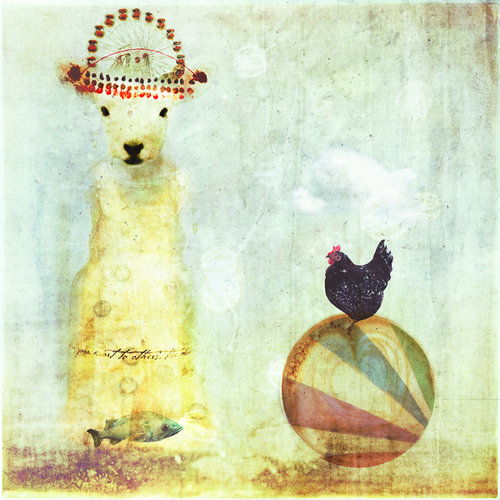Photographer and guest blogger Pamela Viola shares her experience with the realities of being in business as an artist, including the hard work involved and the ultimate rewards.

“Hesitance” pigment print on paper, 2014, 20″ x 20″ by Pamela Viola
I know. You’re an artist. All you want to do is be creative and make your art. If you want art to be your career and pay your bills, you will have to do many things other than create artwork. First, you must realize that not only are you an artist, but also an entrepreneur and a small business owner. There are no one size fits all instructions for building a flourishing art business so instead of providing you with a checklist, I’ll describe my own experience.
As briefly as possible, I’d like to set the stage with a bit of my history. I don’t have an academic degree in art. When I graduated from college in the mid-1980’s, I lived in New York City and attempted to make a living as a fine art photographer. I was exhibiting in group shows, got a couple of grants, but I wasn’t earning much money.
Quickly I moved on to “Plan B”, a 15-year career in film and television production. During that time, I was too busy to make much art. Ten years into that work, I realized how much I missed being creative and knew I needed to find my way back. It took a while, but five years ago I became a full-time professional artist earning my living solely through sales of my work. I’m convinced the internet made it possible.
I will tell you this up front. I spend at least 50% of my time researching new clients and opportunities, marketing and doing administrative work for my art business. Of course without the art there is no business, so that is priority number one. My recommendation is that you make art at the beginning of your day, before looking at email or going off to your “day job” if you have one. It’s too easy to get bogged down with tasks and emotionally drained if you wait until sometime later in the day.

“Balance” pigment print on paper, 2014, 20″ x 20″ by Pamela Viola
A couple of years ago I told this to a young artist who worked in a gallery that represents me. Several months later he said he was getting up an hour earlier every day to make art. This month he has his first solo exhibit.
Next, your work must be seen. Possibilities for this are endless, and that is both good and bad. If at all possible, register your domain name and create your own personal website first. There are many places where artists can create a web presence for free and in some cases sell your work, but in my opinion it is better to choose a couple of well-established sites (Flickr, Facebook, Imagekind) rather than trying to keep a large number up to date.
I am constantly trying to streamline my process of getting work before the public eye. You must continually reevaluate what venues are worth your time and effort. Posting new work and keeping up with social media takes time and one can easily spend hours with these tasks. Do some research, find places where your work fits, and stick with a few rather than trying to cover every outlet.
If you want to sell your artwork, where should you do that? Many artists only think about traditional venues, but there are plenty of niche markets that you may not be familiar with that could be perfect for your work.
It’s important that you take a hard objective look at your art. Are they whimsical silk-screens? Probably a law firm won’t purchase them. Dark, moody abstracts? Not a good fit for the children’s wing of a hospital, but might be great licensed to a manufacturer of silk scarves. A gorgeous photograph of the Everglades? You may not be the next National Geographic photographer, but what about licensing it to an art publisher that is supplying art for a hotel near the Everglades?

“Faceless Man and Holi Dog” pigment print on paper, 2014, 20″ x 20″ by Pamela Viola
None of these scenarios will happen with the snap of your fingers. There is a lot of research that comes along with finding buyers, and much preparation you must do before approaching a potential client.
First, you must have a cohesive body of work. Always remember you are a businessperson. Being an artist is no excuse for presenting yourself and your work in anything less than an organized and professional manner.
Do your research. Gallery directors, art publishers or other art buyers are busy. Never stop by without an appointment and be selective. It is almost always a waste of time to approach someone who represents artists whose work has no commonality with your own.
You’re an artist. Think outside the box as you make your list of potential people and venues to approach. The internet makes it so much easier now to find potential paths to follow. Art is all around us; not just as canvases on walls. Be persistent and it will pay off.


Outstanding article, Pamela. Thank you.
Judy,
I so glad you found the post useful and affirming.
All the best to you,
Pamela
Thank you! I needed to hear this. I have orders and interest and little time to create so am hesitant to sell what I have or even put them on my website for fear of getting more orders. Somehow I need to create more, use the designs in more creative and numerous ways and get up earlier! Your article doesn’t exactly address my situation but it covers so many good things and helped me stop and think it through.
Becky,
Never be hesitant to sell and get orders for your artwork! That is an enviable position. Just be honest with your buyers. Give them an accurate timeframe for delivery or offer to put them on a waiting list for new works. If they like your work, they’ll wait for it. Also, they’ll probably be even more excited about your work because they’ll know it’s in high demand.
All the best to you,
Pamela
Thank you for reminding me that I’m doing things right. Business is 50% of the artists work, despite what others think.
Monica,
We all need to be reminded that we’re on course. Glad I was able to help.
All the best to you,
Pamela
Thank you so much for sharing your knowknowledge and well done on your art career. It is a hard business but as you said a rewarding one. Thank you again for your help. Leanne 🙂
Thank you so much for sharing your experience. It confirms that it is indeed a lot more than just creating. My problem is that you get overwhelmed by sharks these days who only want to take your money instead of promoting your work. My work is not easy to be labeled hence, very difficult to find the right agents or galleries to be represented by. Your article helped me to keep on looking.
Awesome article and awesome artwork.
The mundane, unfortunately, is not easy for the creative soul in many of us. I may suffer from focusing too much detail in my photography and not enough detail with my paperwork. Naw. LOL
Interesting that you mention ImageKind instead of FineArtAmerica. I came to this article via a mention in an FAA newsletter. I am also transitioning my work from ImageKind (even though I’ve been there for several years) to FAA because IK is beginning to have problems; the major one being that their marketing tools “broke” in April and they claim it is too much work to fix them. WTF? Their forum is dead and their blog is stale. FAA has wonderful marketing tools, and an active community.
~ Bill
I work in television also, and it is tough to work on your art. Plus Im trying to fit in physical activity its all a challenge but I will try harder to wake up earlier to get work done. Great article! Hope to keep in touch
Thank You